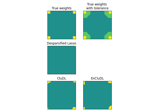hidimstat.desparsified_lasso#
- hidimstat.desparsified_lasso(X, y, dof_ajdustement=False, max_iteration=5000, tolerance=0.001, alpha_max_fraction=0.01, epsilon=0.01, tolerance_reid=0.0001, n_splits=5, n_jobs=1, seed=0, memory=None, verbose=0, group=False, covariance=None, noise_method='AR', order=1, stationary=True)[source]#
Desparsified Lasso
Algorithm based on Algorithm 1 of d-Lasso and d-MTLasso in [Chevalier, 2020].
- Parameters:
- Xndarray, shape (n_samples, n_features)
Input data matrix.
- yndarray, shape (n_samples,) or (n_samples, n_times)
Target vector for single response or matrix for multiple responses.
- dof_ajdustementbool, optional (default=False)
If True, applies degrees of freedom adjustment from Bellec and Zhang[1]. If False, computes original Desparsified Lasso estimator.
- max_iterationint, optional (default=5000)
Maximum iterations for Nodewise Lasso regressions.
- tolerancefloat, optional (default=1e-3)
Convergence tolerance for optimization.
- alpha_max_fractionfloat, optional (default=0.01)
Fraction of max alpha used for Lasso regularization.
- epsilonfloat, optional (default=1e-2)
Small constant used in noise estimation.
- tolerance_reidfloat, optional (default=1e-4)
Tolerance for variance estimation with the Reid method.
- n_splitsint, optional (default=5)
Number of splits for cross-validation in Reid procedure.
- n_jobsint, optional (default=1)
Number of parallel jobs. Use -1 for all CPUs.
- seedint, default=0
Random seed for reproducibility.
- memorystr or joblib.Memory object, optional (default=None)
Used to cache the output of the computation of the Nodewise Lasso. By default, no caching is done. If a string is given, it is the path to the caching directory.
- verboseint, default=0
Verbosity level for logging.
- groupbool, default=False
If True, use group Lasso for multiple responses.
- covariancendarray, shape (n_times, n_times), default=None
Temporal covariance matrix of the noise. If None, it is estimated.
- noise_method{‘AR’, ‘median’}, default=’AR’
Method to estimate noise covariance: - ‘median’: Uses median correlation between consecutive
timepoints
‘AR’: Fits autoregressive model of specified order
- orderint, default=1
Order of AR model when noise_method=’AR’. Must be < n_times.
- stationarybool, default=True
Whether to assume stationary noise in estimation.
- Returns:
- beta_hatndarray, shape (n_features,) or (n_features, n_times)
Desparsified Lasso coefficient estimates.
- sigma_hat/theta_hatfloat or ndarray, shape (n_times, n_times)
Estimated noise level (single response) or precision matrix (multiple responses).
- precision_diagonalndarray, shape (n_features,)
Diagonal elements of the precision matrix.
Notes
The columns of X and y are always centered, this ensures that the intercepts of the Nodewise Lasso problems are all equal to zero and the intercept of the noise model is also equal to zero. Since the values of the intercepts are not of interest, the centering avoids the consideration of unecessary additional parameters. Also, you may consider to center and scale X beforehand, notably if the data contained in X has not been prescaled from measurements.
References

